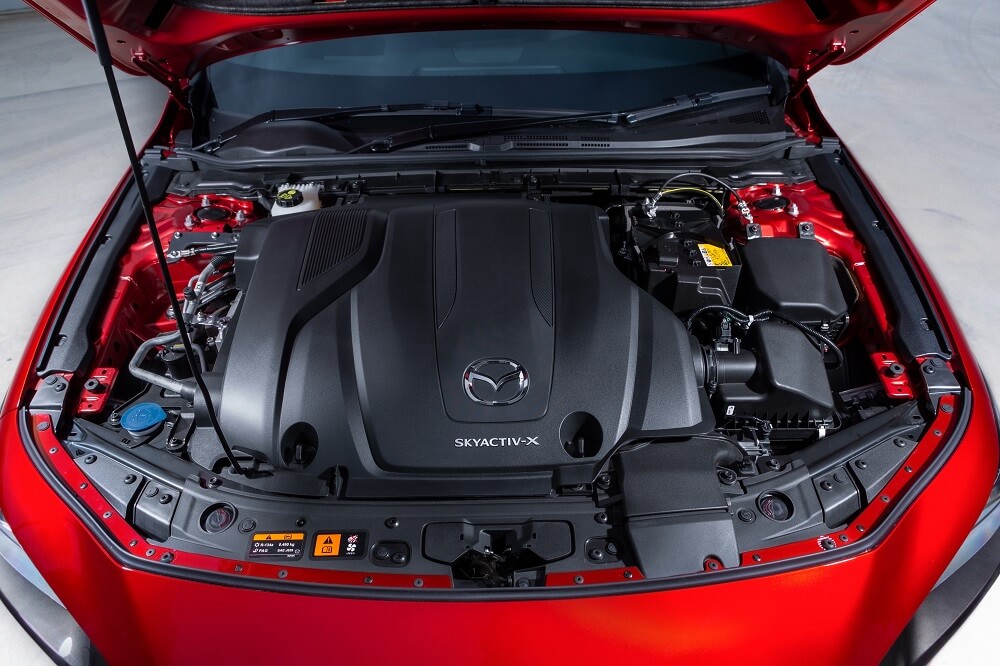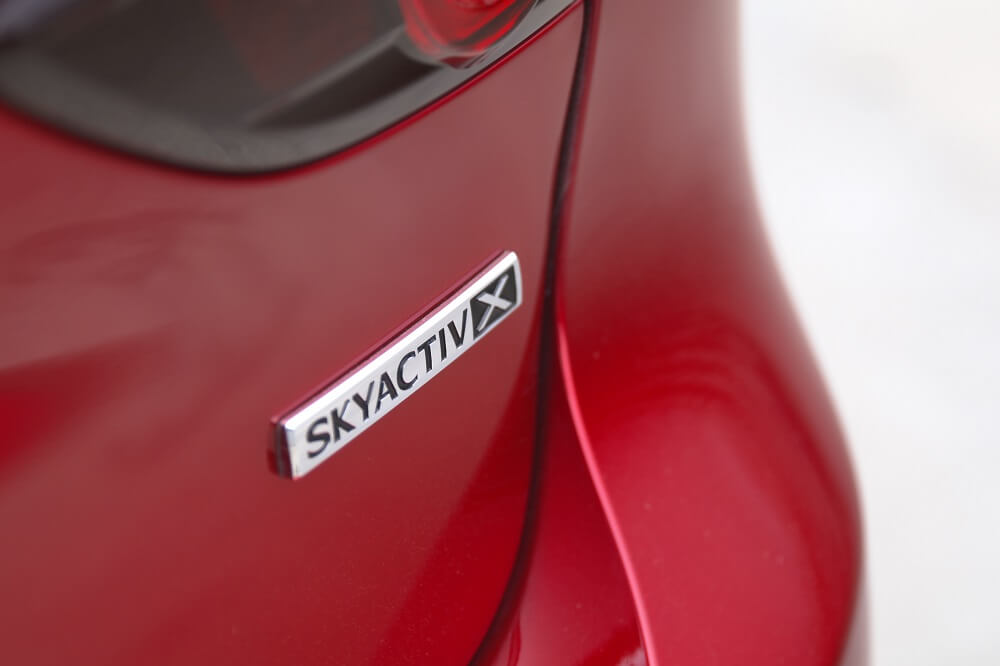Mazda hybrid boasts impressive new tech

Almost two decades after Toyota launched its ground-breaking Prius hybrid, Mazda has returned serve by announcing the launch of its own petrol-electric hybrid models.
The Japanese brand is more accustomed to leading than trailing the pack, particularly with regards to new technology, but its journey to electrification has been slower than many of its rivals.
However, in a classic case of “better late than never”, the Hiroshima-based brand has announced the launch of its first hybrid-electric powertrain, dubbed Skyactiv-X M Hybrid, with a new Mazda3 variant that launched Australia-wide on 1 August. It will be followed in September by a Skyactiv-X M Hybrid version of the popular CX-30 compact SUV.
In both cases the new mild-hybrid technology will only be available on top-of-the-range Astina variants, with the Mazda3 X20 Astina priced from $40,590 (MRLP), and the CX-30 X20 Astina AWD priced at $46,490 (MRLP). That’s a jump of exactly $3000 over the previous range-topping G25 Astina models for both models.
While the addition of a 24V lithium-ion battery to the drivetrain of these petrol-powered Mazdas might trail the introduction of similar technology by rival car makers, Mazda is keen to point out that this is the first such application of hybrid-tech with its proprietary Skyactiv engine technology.
Mazda first introduce Skyactiv to its local range back in 2012 and has continued to refine the technology and introduce it to a growing number of its models in the ensuing years.
The company claims Skyactiv’s unique combustion chamber design and combustion-cycle technology achieves the high-revving performance of a petrol engine with the fuel efficiency, torque and response of a diesel.

Over and above that, the new 2.0-litre Skyactiv-X M Hybrid at the heart of the Mazda3 X20 and the CX-30 X20 is claimed to be the world’s first production petrol unit to exploit the benefits of diesel-like compression ignition.
According to Mazda, Skyactiv-X utilises something called Spark Controlled Compression Ignition (SPCCI), a new engineering concept that allows the engine to switch seamlessly between conventional spark ignition and compression ignition combustion by using a spark to trigger both types of combustion in different ways.
In SPCCI mode, a split injection process creates separate zones of fuel-air mixture inside the combustion chamber, Mazda claims.
First, a very lean fuel-to-air mixture is injected into the combustion chamber during the intake stroke, and then a zone of atomised fuel is precisely injected directly around the spark plug during the compression stroke.
That small injection of atomised fuel directly around the spark plug builds a richer core so that when the spark fires, it ignites this core of fuel and air.
This increases pressure in the combustion chamber to the point where the lean mixture rapidly combusts.
.jpg?rev=e92df29de42f4a409e7a1ddf7c6121ba&hash=E65B44029215CA4BEAC320EB3599C9E5)
In the case of these two new models, Skyactiv-X is combined with a compact and efficient mild-hybrid system dubbed Mazda M Hybrid.
It features a belt-driven integrated starter generator (ISG) and a 24V lithium-ion battery.
Mazda says the combination never directly drives the vehicle but instead supports greater gains in fuel economy by recycling energy recovered during deceleration and powering the ISG, which effectively functions as an electric motor, to assist the engine.
We’ve not yet had the opportunity to drive the new models but Mazda claims the new 2.0-litre Skyactiv-X M Hybrid offers “a premium driving feel that enhances the refinement of its vehicles”, and along with being its first use of electrification on its vehicles, is the next step in its multi-solution approach to reducing emissions.
Like many car companies, Mazda has set itself strict emissions targets, including a 50% reduction of corporate average "well-to-wheel" carbon dioxide emissions by 2030, based on its 2010 levels, and a 90% reduction on those levels by 2050.
Mazda cites the introduction of the Skyactiv-X engine as a major milestone in its achieving these goals, adding that it believes internal combustion engines will continue to power the majority of cars worldwide for many years to come.
Related topics
Things to note
The information in this article has been prepared for general information purposes only and is not intended as legal advice or specific advice to any particular person. Any advice contained in the document is general advice, not intended as legal advice or professional advice and does not take into account any person’s particular circumstances. Before acting on anything based on this advice you should consider its appropriateness to you, having regard to your objectives and needs.
Insurance Products (excluding Travel Insurance) are issued by RACQ Insurance Limited ABN 50 009 704 152 (RACQI) and arranged by its agent, RACQ Distribution Services Pty Ltd (RDS) ABN 35 116 361 650, AFSL 567130 and RDS' authorised representatives (including RACQ Operations Pty Ltd ABN 80 009 663 414, AR No. 234978 (RACQO). Conditions, limits and exclusions apply. RDS and RACQO are in the RACQ group of companies. One of the companies in the RACQ group of companies has a minority shareholding in RACQI.
RDS and RACQO have not taken your personal objectives, circumstances or needs into account when preparing advice regarding insurance products and you will need to consider whether the advice is appropriate for you. Read the Product Disclosure Statement (PDS) and any applicable Supplementary PDS before making a purchase decision on this product. You can also access our Target Market Determinations on this website. RDS receives a commission from RACQI for the policies it arranges. RACQO receives fees paid for services it provides to RDS. Further details about remuneration are available on request prior to purchasing.
Banking and loan products issued by Members Banking Group Limited ABN 83 087 651 054 AFSL/Australian credit licence 241195 trading as RACQ Bank. Terms, conditions, fees, charges and lending policies apply. This is general advice only and may not be right for you. This information does not take your personal objectives, circumstances or needs into account. Read the disclosure documents for your selected product or service, including the Financial Services Guide and the Terms and Conditions, and consider if appropriate for you before deciding.
Except for RACQ Bank, any RACQ entity referred to on this page is not an authorised deposit-taking institution for the purposes of the Banking Act 1959 (Cth). That entity’s obligations do not represent deposits or other liabilities of RACQ Bank. RACQ Bank does not guarantee or otherwise provide assurance in respect of the obligations of that entity, unless noted otherwise.
RACQ Bank subscribes to the Customer Owned Banking Code of Practice which establishes higher standards than the law requires. The Code reflects modern consumer expectations and developments in approaches to issues such as consumer vulnerability, guarantors, and supporting customers through financial hardship. Please read our Customer Owned Banking Code of Practice page for more information.
RACQ Operations Pty Ltd (ABN 80 009 663 414 AR 000234978) and Members Travel Group Pty Ltd (ABN 45 144 538 803 AR 000432492) are acting as an Authorised Representative of the issuer of the insurance, Tokio Marine & Nichido Fire Insurance Co., Ltd. (ABN 80 000 438 291 AFSL 246 548). Any advice set out above is general in nature only, and does not take into account your objectives, financial situation or needs. Before purchasing any travel products, please consider the RACQ Travel Insurance Product Disclosure Statement (PDS) and the Target Market Determinations (TMDs) that apply to these products. Whilst the PDS outlines the Terms and Conditions of these products, the TMDs outline the intended class of customers that comprise the target market for these travel products. This will allow you to consider which products best suit your objectives, financial situation and needs and consider the products appropriateness to your personal circumstances. TMDs also outline matters involving the distribution and the review of these products. The PDS, Supplementary PDS and TMDs for each travel product can be found here.

